

You are using an out of date browser. It may not display this or other websites correctly.
You should upgrade or use an alternative browser.
You should upgrade or use an alternative browser.
dbltree
Super Moderator
what about kale? good for late winter? and can it be mixed with turnip and other brassics ?
Kale is a great brassica and it can be (and often is) mixed with with other brassicas, kale however is a long season brassica (120-150 day) while it's sister brassica (rape/canola) is 90 day...no big deal but kale will not achieve it's maximum growth planted in mid July.
Kale also does not have a root like turnips so will work well at first but probably not a great late winter plant.
Welter Seed carries both kale and swedes (swedes are the long season version of turnips) if you would like to give them a try this year...:way:
dbltree
Super Moderator
February 1st 2011
Turnips....the last to be touched in these strip plots but now are invaluable in holding deer on my farm through the winter

They are gnawing them right into the dirt

Not wasting so much as a morsel

and with a blizzard barreling at us threatening to drop up to 18" of snow, deer will soon be working even harder to clean up the last scraps of the tasty turnips! :way:

Turnips....the last to be touched in these strip plots but now are invaluable in holding deer on my farm through the winter

They are gnawing them right into the dirt

Not wasting so much as a morsel

and with a blizzard barreling at us threatening to drop up to 18" of snow, deer will soon be working even harder to clean up the last scraps of the tasty turnips! :way:

dbltree
Super Moderator
Paul, do you apply 300-400#'s of 6-24-24 and 200#'s of urea (46-0-0) nitrogen right at planting time?
Yes...I till it in, cultipack then broadcast seed and re-cultipack :way:
dbltree
Super Moderator
Just a reminder that if you planted brassicas this past year, you'll want to get a cover crop planted in the spring. I have not had the best luck attempting to frost seed red clover into the dead brassicas because of the allelopathic chemicals left behind from the dead plant residue so I prefer to till everything under and plant an annual clover.
Berseem or crimson clovers work well and can be planted with oats and then one can till that under in late summer for the fall cereal grain planting.
Buckwheat is another option but I prefer to use a legume cover crop to take advantage of the nitrogen fixing qualities.
If you have almost no plant residue left then frost seeding clover may work very well...perhaps I'm just looking for an excuse to "stir some dirt" first thing in the spring...
Berseem clover - sow 10-20#'s per acre
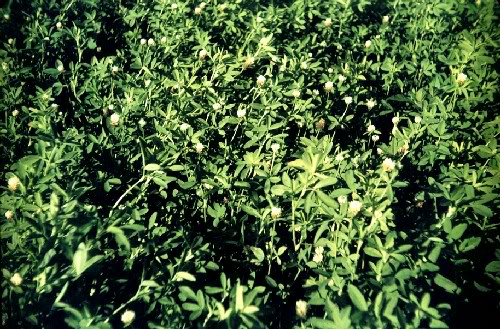
Crimson Clover - sow 25-35#'s per acre
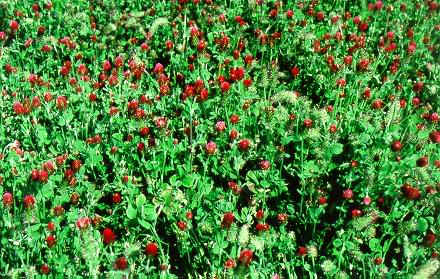
Source for clover seed Welter Seed
Don't leave the soil bare and unproductive, keep it working and your deer coming to that plot by planting a cover crop...:way:
Berseem or crimson clovers work well and can be planted with oats and then one can till that under in late summer for the fall cereal grain planting.
Buckwheat is another option but I prefer to use a legume cover crop to take advantage of the nitrogen fixing qualities.
If you have almost no plant residue left then frost seeding clover may work very well...perhaps I'm just looking for an excuse to "stir some dirt" first thing in the spring...
Berseem clover - sow 10-20#'s per acre

Crimson Clover - sow 25-35#'s per acre

Source for clover seed Welter Seed
Don't leave the soil bare and unproductive, keep it working and your deer coming to that plot by planting a cover crop...:way:
B
bern381
Guest
Paul, two questions. First, do you plant this mix Winter rye 50-80#'s per acre (56#'s = a bushel)
Spring oats 80-120#'s per acre (32#'s = a bushel)
Austrian Winter Peas 20-80#'s per acre (4010 or 6040 field peas will work fine for 1/2 the price)
Groundhog Forage Radish 5#'s per acre
Red Clover 8-12#'s per acre or white clover at 6#'s per acre
at the same time. I'm in Ohio and due to football/teaching commitments I was thinking of trying to plant the first or second week of August. Second, I am originally from the thumb (Sebewaing). What part of the thumb do you hail from? Thanks, Bill
Spring oats 80-120#'s per acre (32#'s = a bushel)
Austrian Winter Peas 20-80#'s per acre (4010 or 6040 field peas will work fine for 1/2 the price)
Groundhog Forage Radish 5#'s per acre
Red Clover 8-12#'s per acre or white clover at 6#'s per acre
at the same time. I'm in Ohio and due to football/teaching commitments I was thinking of trying to plant the first or second week of August. Second, I am originally from the thumb (Sebewaing). What part of the thumb do you hail from? Thanks, Bill
Paul, two questions. First, do you plant this mix Winter rye 50-80#'s per acre (56#'s = a bushel)
Spring oats 80-120#'s per acre (32#'s = a bushel)
Austrian Winter Peas 20-80#'s per acre (4010 or 6040 field peas will work fine for 1/2 the price)
Groundhog Forage Radish 5#'s per acre
Red Clover 8-12#'s per acre or white clover at 6#'s per acre
at the same time. I'm in Ohio and due to football/teaching commitments I was thinking of trying to plant the first or second week of August. Second, I am originally from the thumb (Sebewaing). What part of the thumb do you hail from? Thanks, Bill
I'm in the same boat as you. I also teach/coach and I am very busy in August with football practice. I think this year I planted LC's cereal grain mix on 8/20 and the plot turned out awesome. I have planted this mix as early as mid-August with no negative effects. Keep in mind my plots are fairly small (less than an acre) and are around cover. The deer never let the rye get more than 3" tall except directy in front of my blind and now it is eaten to the ground. I definetly wouldn't plant it before August or even the first week of August, but in my case anytime from 8/15-9/1 I have had great luck in SE Ohio. It's hard for me to get anything done once school starts so I am forced to plant maybe a little earlier than what I should, but the deer pop around me keeps the plot nice and short for me. I have also found the turkeys love the rye mix as well.
Last year I didn't add any peas or radishes (just rye, oats and clover). This year I plan to add them both.
B
bern381
Guest
If you are going to plant rye, oats, and clover do you plant peas and radishes first and add the cereal grains later. Should I plant radishes and peas in mid july and plant cereal grains before two-adays?
If you are going to plant rye, oats, and clover do you plant peas and radishes first and add the cereal grains later. Should I plant radishes and peas in mid july and plant cereal grains before two-adays?
Two-a-days........the reason I got out of high school coaching. I enjoy middle school much better, you actually make money
Our high school two-a-days are usually the first two weeks in August. I don't know how yours work. I would just find a time your off and plant on a Sunday (unless you don't have 2 a days on Saturdays). That's what I did. It doesn't give you much of a window. I plan when I get a free moment from coaching and the wife.
I like to plant my brassicas around Mid-July here in Ohio. Some people plant them as late as the first week in August. I plan my brassicas for one thing......tonnage. I would as much growth as I can and not have them seed out and die. Usually planting mid-July will give you a solid 75-90 days before first frost.
dbltree
Super Moderator
February 14th, 2011
Been a tough winter but this only amplifies the need for year around food sources that not only attract deer but hold them on our property while keeping them well fed and not stressed. Healthy does have big healthy fawns and healthy strong bucks will likely grow like kind antlers so all the more reason to make sure they have a food source that will last as long as possible.
Turnips...the things they wouldn't touch last fall are now their saving grace!

I plant a mix of forage radish, forage rape and turnips in mid July and....they eat them in that order leaving the turnips unscathed to be eaten when they need them most.

These turnips have helped keep deer focused on the very same plot they have fed in all year and for years before that

Deer are so much easier to kill if they are adapted and predictable and we can't do that if we only "feed" them for 2 months out of the year

Mine aren't the only turnips being hit this time of year...these are from a friends plots
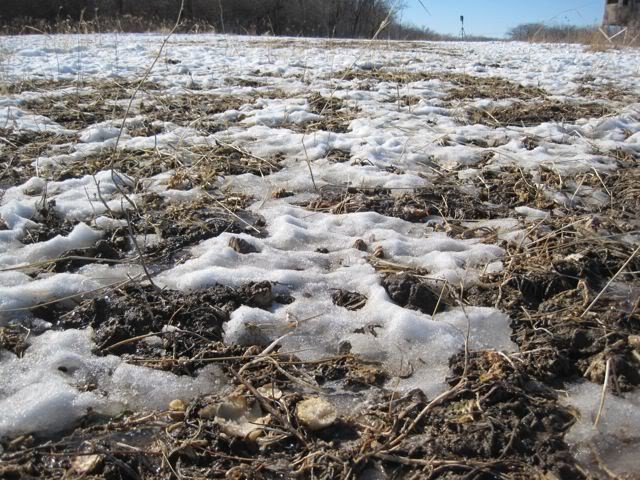
and where there is a winter food source...you'll find "presents"
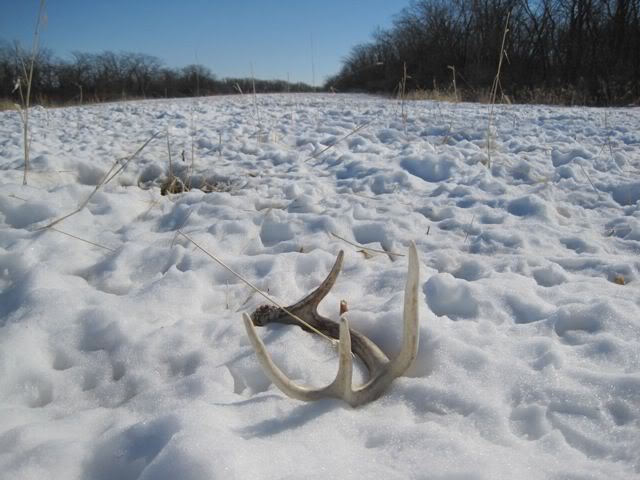
They don't look like much but to a cold hungry whitetail it's a prize to be savored!
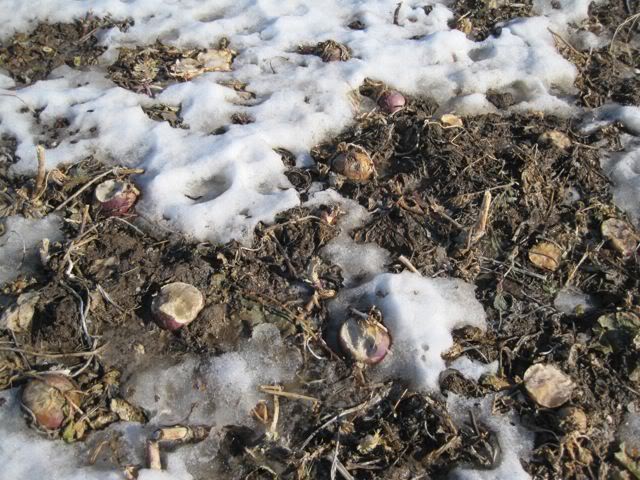
Brassica plots are trampled
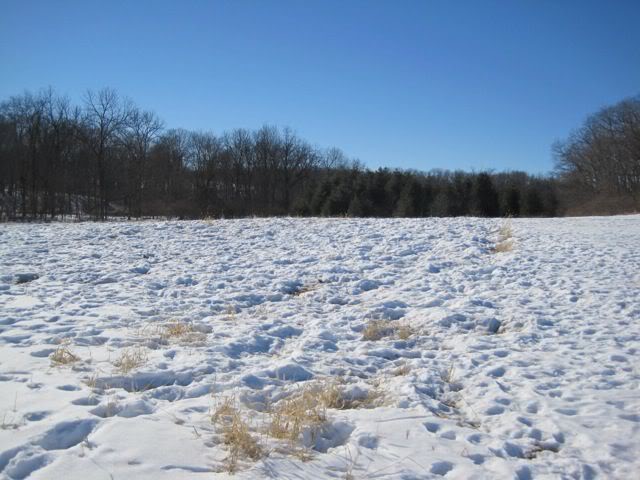
Because the corn and beans are long gone!

Some well fertilized brassicas that include turnips can be an extremely useful tool in keeping whitetails on your farm and an arm load of sheds will be only one of the rewards you will reap from planting them.....
Been a tough winter but this only amplifies the need for year around food sources that not only attract deer but hold them on our property while keeping them well fed and not stressed. Healthy does have big healthy fawns and healthy strong bucks will likely grow like kind antlers so all the more reason to make sure they have a food source that will last as long as possible.
Turnips...the things they wouldn't touch last fall are now their saving grace!

I plant a mix of forage radish, forage rape and turnips in mid July and....they eat them in that order leaving the turnips unscathed to be eaten when they need them most.

These turnips have helped keep deer focused on the very same plot they have fed in all year and for years before that

Deer are so much easier to kill if they are adapted and predictable and we can't do that if we only "feed" them for 2 months out of the year

Mine aren't the only turnips being hit this time of year...these are from a friends plots

and where there is a winter food source...you'll find "presents"

They don't look like much but to a cold hungry whitetail it's a prize to be savored!

Brassica plots are trampled

Because the corn and beans are long gone!

Some well fertilized brassicas that include turnips can be an extremely useful tool in keeping whitetails on your farm and an arm load of sheds will be only one of the rewards you will reap from planting them.....
dbltree
Super Moderator
February 24th, 2011
A good crop of turnips is a sure bet to hold deer on your property all winter!

They are one of the few crops one can usually count on to still be attracting deer in late winter

Yours and the neighbors too!

Some of the neighbors bucks may decide year around food and cover is more to their liking

They are eating the GHF radish roots

and the turnips

pretty much equally

No matter who's farm or food plot...the brassicas are a busy place this time of year!
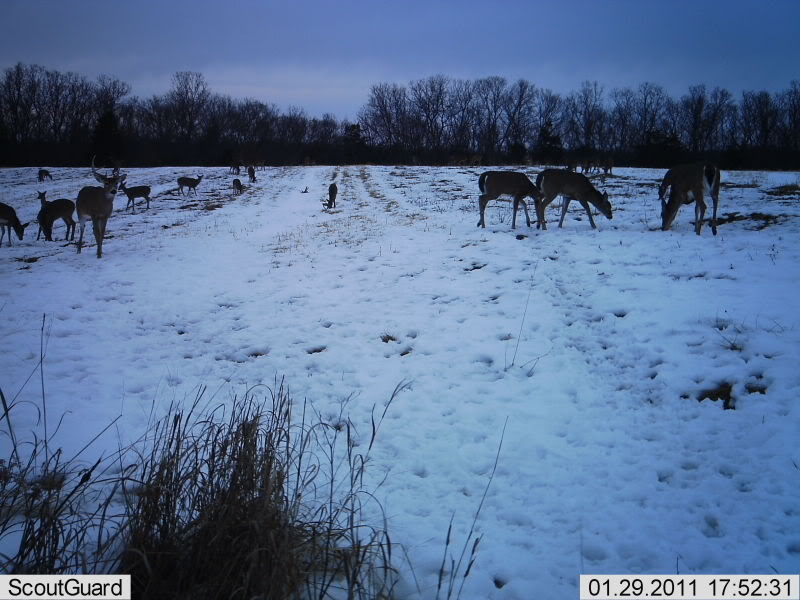
Mike found these sheds in his sugar beets and soybeans but none in his corn much to his surprise but still they are there because he has enough feed to last all winter
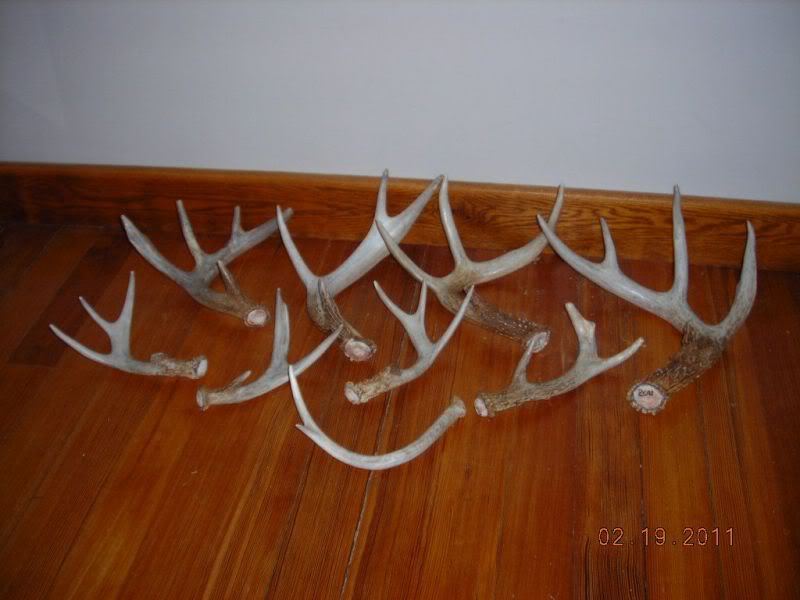
Plan for year around food sources and all of them in one place or at least all of them in each field to adapt deer to traveling the same routes every day, year in, year out.... :way:
A good crop of turnips is a sure bet to hold deer on your property all winter!

They are one of the few crops one can usually count on to still be attracting deer in late winter

Yours and the neighbors too!

Some of the neighbors bucks may decide year around food and cover is more to their liking

They are eating the GHF radish roots

and the turnips

pretty much equally

No matter who's farm or food plot...the brassicas are a busy place this time of year!

Mike found these sheds in his sugar beets and soybeans but none in his corn much to his surprise but still they are there because he has enough feed to last all winter

Plan for year around food sources and all of them in one place or at least all of them in each field to adapt deer to traveling the same routes every day, year in, year out.... :way:
SDHunt24/7
New Member
Similar product to biologic maximum?
Does welter's or anyone else have a mix that is similar to biologic maximum? I have used this stuff the last two years and the deer have went nuts over it. It just keeps climbing in price and I have seen where you guys talk about steering away from the "deer on the bag" brands to save some $. I would also be interested in something similar to their outfitters blend. Dbltree do you have the make up list for these products? I couldn't find it anywhere and have thrown the old open bags away.
Does welter's or anyone else have a mix that is similar to biologic maximum? I have used this stuff the last two years and the deer have went nuts over it. It just keeps climbing in price and I have seen where you guys talk about steering away from the "deer on the bag" brands to save some $. I would also be interested in something similar to their outfitters blend. Dbltree do you have the make up list for these products? I couldn't find it anywhere and have thrown the old open bags away.
dbltree
Super Moderator
Does welter's or anyone else have a mix that is similar to biologic maximum? I have used this stuff the last two years and the deer have went nuts over it. It just keeps climbing in price and I have seen where you guys talk about steering away from the "deer on the bag" brands to save some $. I would also be interested in something similar to their outfitters blend. Dbltree do you have the make up list for these products? I couldn't find it anywhere and have thrown the old open bags away.
I plant the following...
3#'s Purple Top Turnips
2#'s Dwarf Essex Rape
5#'s GroundHog Forage Radish
till in 200#'s urea and 400#'s 6-24-24 before planting
Welter seed has those and many more varieties...all of which I have tried and all work well I might add!
Welter Seed - Brassica seed
The combination above will attract and feed deer from August through March if you plant mid July (give or take) and feed it well!
You can experiment with other varieties such as Pasja or Appin or Barkant but the old standbys listed above have never failed me...:way:
dbltree
Super Moderator
Many landowners only "see" the deer on their property during hunting season and the rest of the year they are out of sight and out of mind. They may use trail cams improperly and/or on a limited basis so they don't really have a feel for what is actually living on their property and without that information they cannot then fathom the reason for year around cover and food....just plant some stuff and they'll show up this fall...right??
There is of course some truth to that but if we provide everything that whitetails need to not only survive, but thrive on our property, they will become as predictable as death and taxes. Over time they will become so adapted to traveling the same runways to the same field to feed they become amazingly easy to kill.
If the field is barren for half the year...where do you suppose they will go? What patterns are they forced to change and they become anything but predictable.
Remember this strip of brassicas from the past summer? Lush and green...food aplenty!

ahhh...but now it is far from that and bare as a table top!
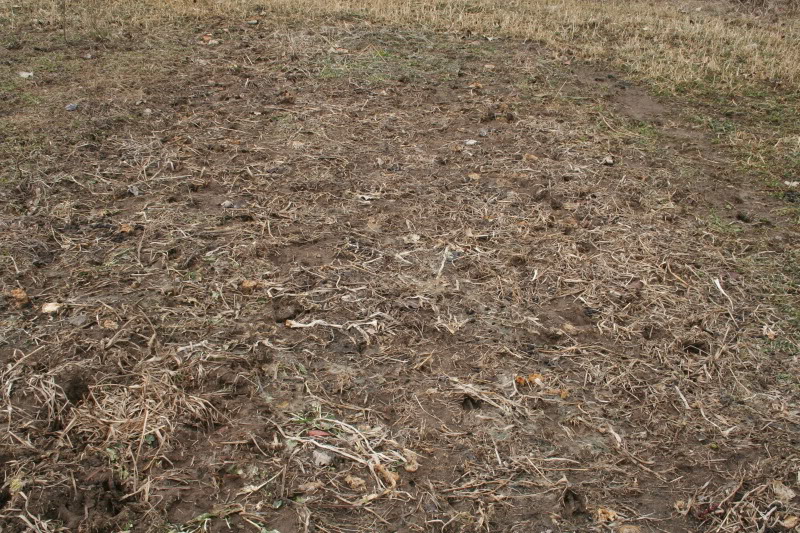
When an entire field is planted to brassicas, beans or corn for instance...eventually they clean it up leaving nothing in that field and forcing deer to change patterns and adapt to another field or food source.
In my case though the entire plot is NOT bare and despite being early March there is enough to keep them returning to feed. Clover on the left, rye on the right keep them coming back!
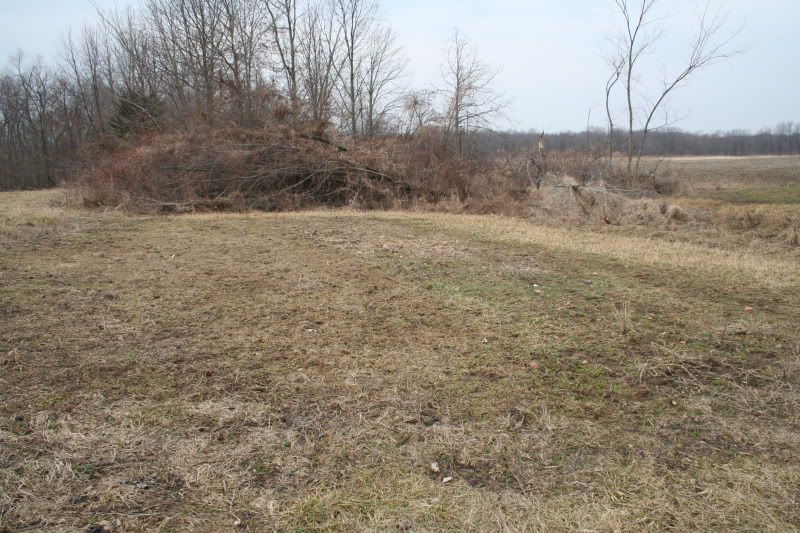
I also overseeded winter rye into the forage radish as it was being decimated early on so rather then have a bare spot...I have a great food source and soil builder to boot!
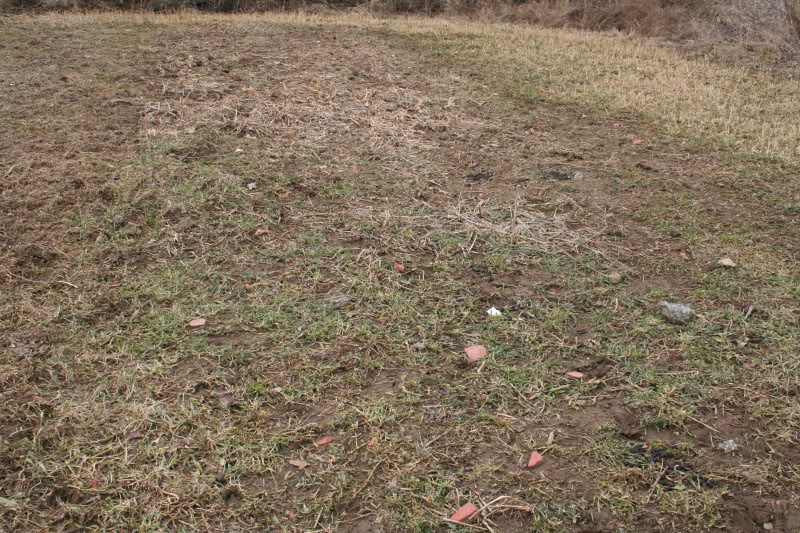
At a glance the ground appears brown and barren but a closer look reveals white clover...tender morsels that they cannot resist and at a time of year when they are stressed to the max.

On the other side it appears much the same...
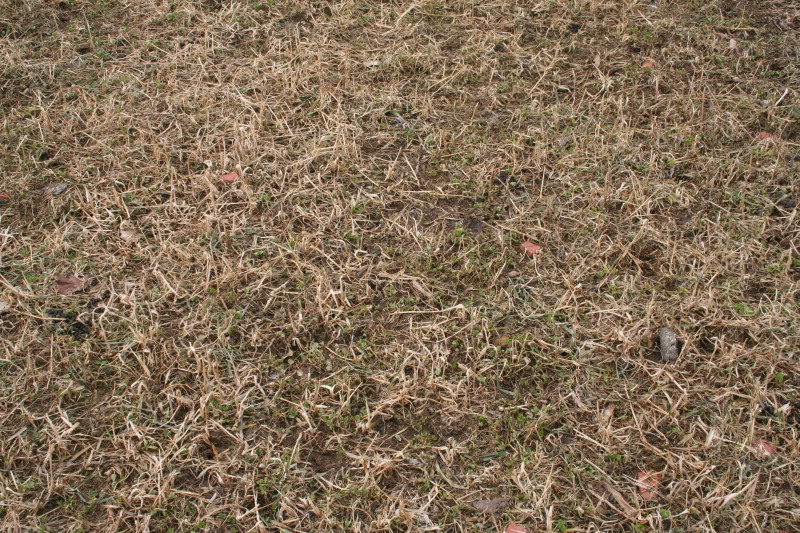
but winter rye and red clover

are both green
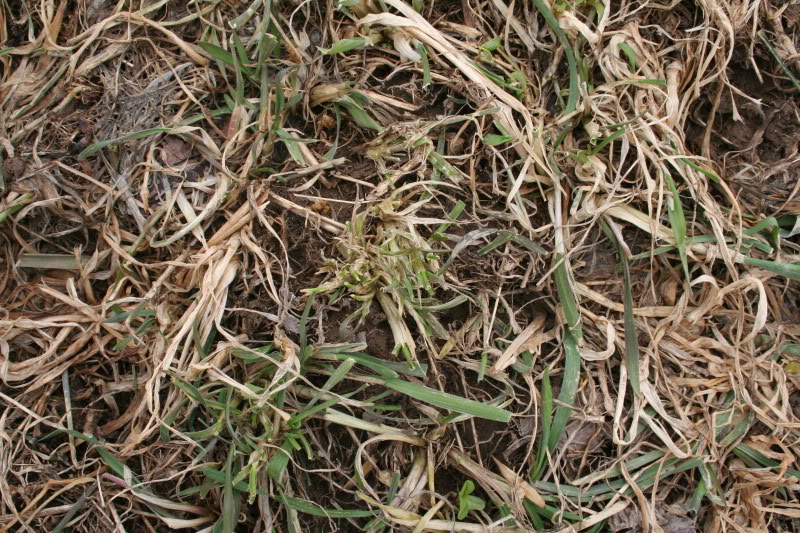
and waiting to provide lush early spring feed
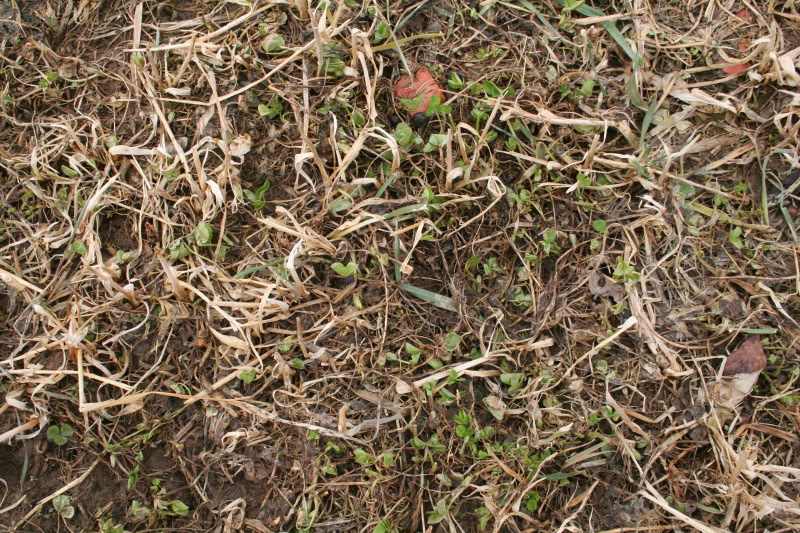
I have not hundreds but thousands of trail cam pics of the deer feeding in these various strip plots on any given day through out the year.
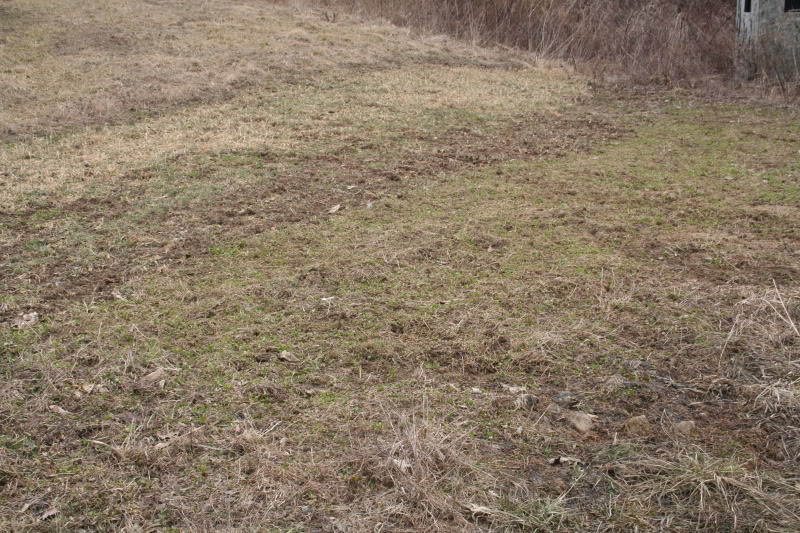
Even with acres of ag crops surrounding them...these plots get hit daily
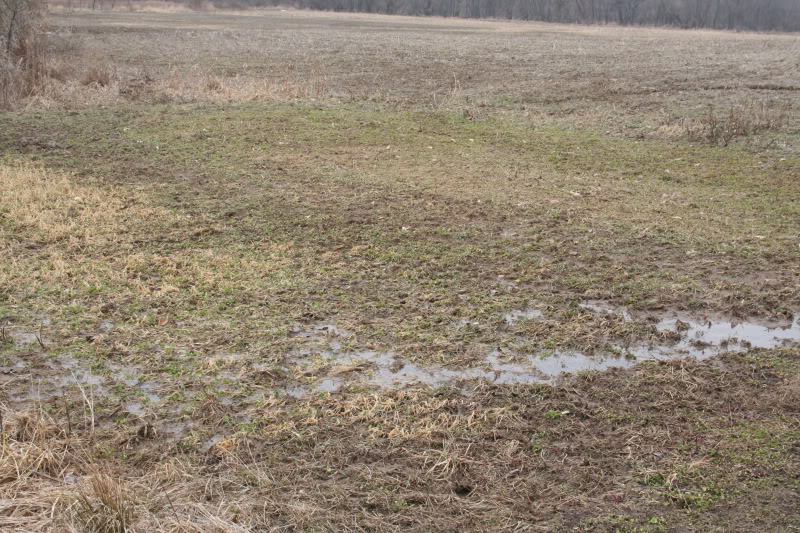
and the deer on my place are adapted and predictable
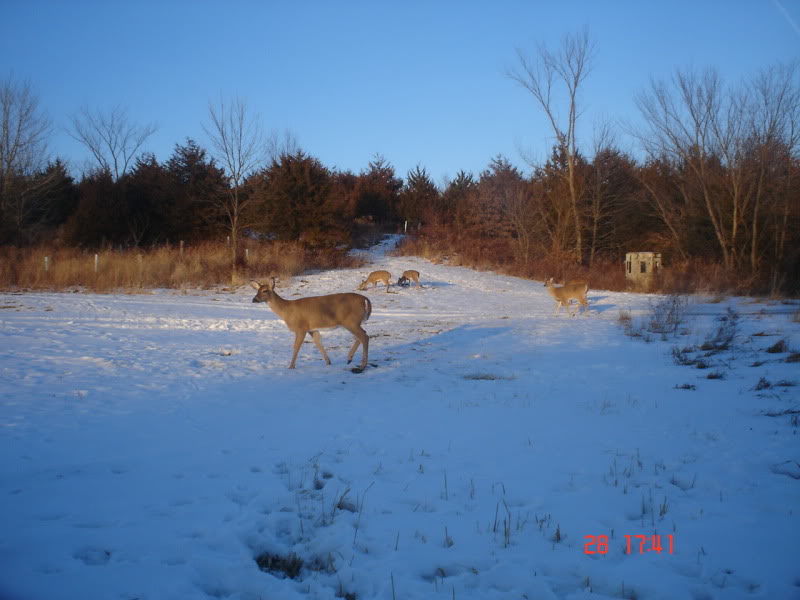
Family groups follow the same runways day after day, year after year...using the same hinged funnels the rutting bucks now exactly where both the feed and the girls are...and it never ever changes.
Go ahead...stick the old ways and leave your fields bare...your neighbors will love you for it....
There is of course some truth to that but if we provide everything that whitetails need to not only survive, but thrive on our property, they will become as predictable as death and taxes. Over time they will become so adapted to traveling the same runways to the same field to feed they become amazingly easy to kill.
If the field is barren for half the year...where do you suppose they will go? What patterns are they forced to change and they become anything but predictable.
Remember this strip of brassicas from the past summer? Lush and green...food aplenty!

ahhh...but now it is far from that and bare as a table top!

When an entire field is planted to brassicas, beans or corn for instance...eventually they clean it up leaving nothing in that field and forcing deer to change patterns and adapt to another field or food source.
In my case though the entire plot is NOT bare and despite being early March there is enough to keep them returning to feed. Clover on the left, rye on the right keep them coming back!

I also overseeded winter rye into the forage radish as it was being decimated early on so rather then have a bare spot...I have a great food source and soil builder to boot!

At a glance the ground appears brown and barren but a closer look reveals white clover...tender morsels that they cannot resist and at a time of year when they are stressed to the max.

On the other side it appears much the same...

but winter rye and red clover

are both green

and waiting to provide lush early spring feed

I have not hundreds but thousands of trail cam pics of the deer feeding in these various strip plots on any given day through out the year.

Even with acres of ag crops surrounding them...these plots get hit daily

and the deer on my place are adapted and predictable

Family groups follow the same runways day after day, year after year...using the same hinged funnels the rutting bucks now exactly where both the feed and the girls are...and it never ever changes.
Go ahead...stick the old ways and leave your fields bare...your neighbors will love you for it....
dbltree
Super Moderator
March 22nd, 2011
The brassica patches are a pretty inhospitable looking place right now...
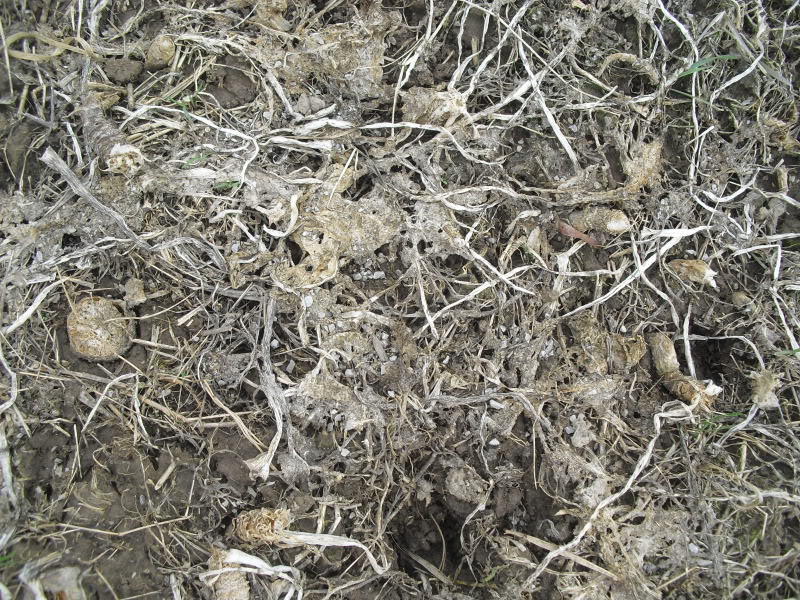
the remains are starting to rot and decay and the allelopathic chemicals can some times make frost seeding clover a losing proposition. I prefer to either till the mess under and plant oats and annual clovers like berseem or crimson or no-till soybeans into the dead brassicas.
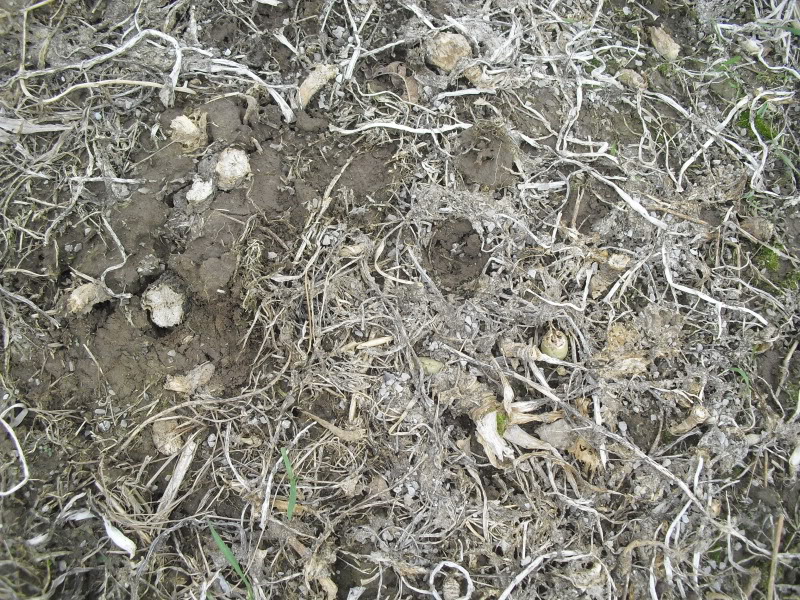
In either event, leaving it bare is the worst thing you can do for your soil and your deer get it planted to something asap this spring.
What about the GroundHog forage radish patch? Remember those huge radish roots? The ones that scavenged nitrogen and pulled potassium from the sub soil? They've done their duty and now are also a decaying mess....
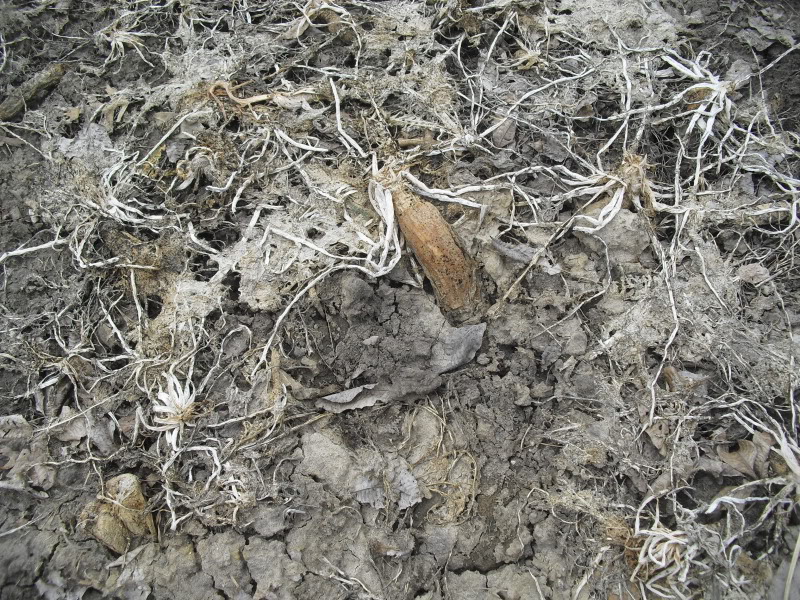
Unlike the other brassicas however they have done something else...the deep roots started to decompose earlier and allowed water to flow in and the freezing/thawing effect also had a profound effect on the soil!
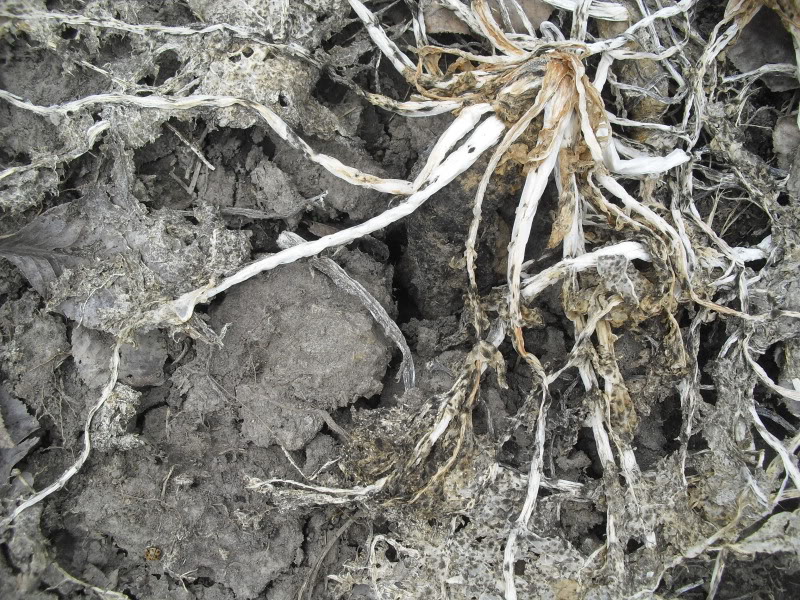
I took the end of a small steel electric fence post and easily stirred the now fluffy and loose soil
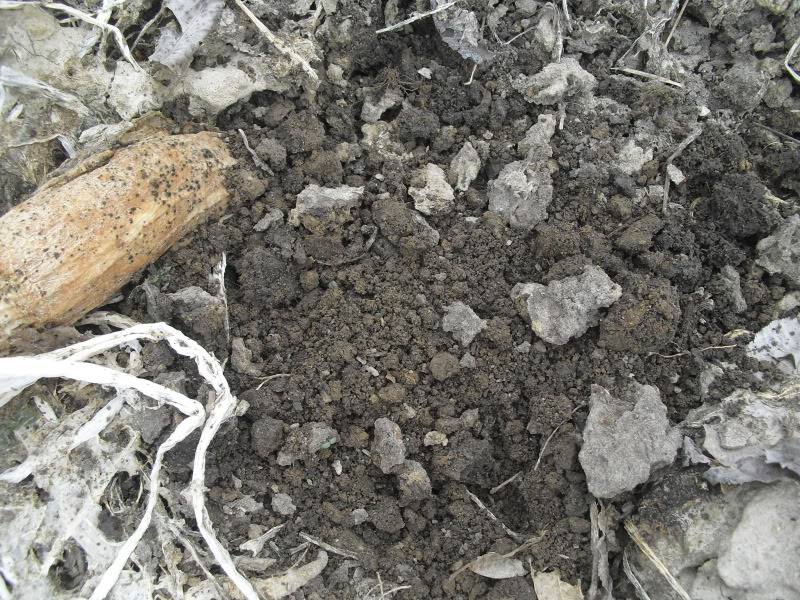
While the areas not planted were hard as a rock and compacted still! The GHFR roots act like natures subsoiler and loosened the heavy clay soils....and attracted deer like a magnet to boot!
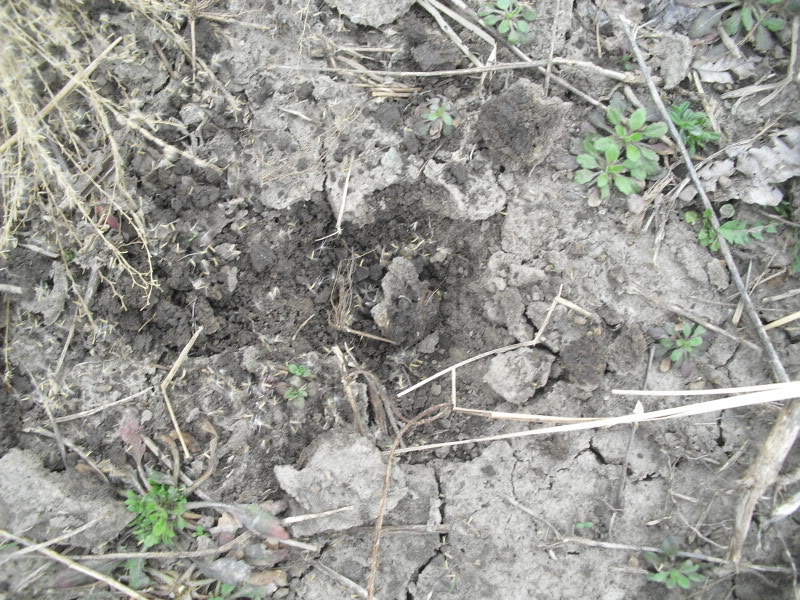
I'm not sure which plant this is...one of the brassica seeds I planted in the garden last fall
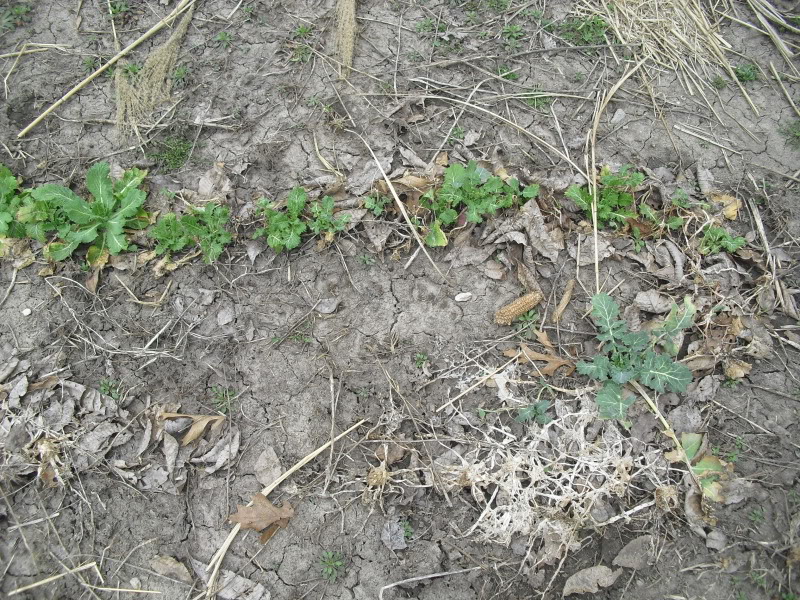
and still alive and well this spring?!
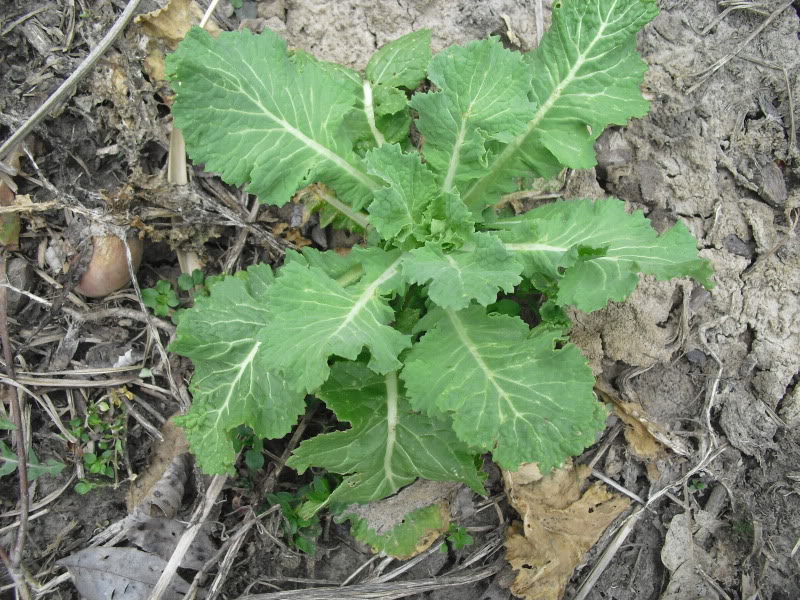
These plants can be a problem however when they go to seed and all the more reason to either till the plot under or plant RR beans or corn and get "problems" killed early on.....
The brassica patches are a pretty inhospitable looking place right now...

the remains are starting to rot and decay and the allelopathic chemicals can some times make frost seeding clover a losing proposition. I prefer to either till the mess under and plant oats and annual clovers like berseem or crimson or no-till soybeans into the dead brassicas.

In either event, leaving it bare is the worst thing you can do for your soil and your deer get it planted to something asap this spring.
What about the GroundHog forage radish patch? Remember those huge radish roots? The ones that scavenged nitrogen and pulled potassium from the sub soil? They've done their duty and now are also a decaying mess....

Unlike the other brassicas however they have done something else...the deep roots started to decompose earlier and allowed water to flow in and the freezing/thawing effect also had a profound effect on the soil!

I took the end of a small steel electric fence post and easily stirred the now fluffy and loose soil

While the areas not planted were hard as a rock and compacted still! The GHFR roots act like natures subsoiler and loosened the heavy clay soils....and attracted deer like a magnet to boot!

I'm not sure which plant this is...one of the brassica seeds I planted in the garden last fall

and still alive and well this spring?!

These plants can be a problem however when they go to seed and all the more reason to either till the plot under or plant RR beans or corn and get "problems" killed early on.....
IQDM
New Member
HA HA! well said! Deer are creatures of habit, and if you can do as dbltree does and create a situation where your deer adapt to a yearlong routine, death will be a very predictable outcome to the deer you are hunting!if we provide everything that whitetails need to not only survive, but thrive on our property, they will become as predictable as death and taxes.
dbltree
Super Moderator
April 15th, 2011
Here is a great example why we need to turn under spent brassica plots and get them in a cover crop of oats and an annual clover like berseem or crimson. It's only April 15th and these surviving brassicas planted as a test in my garden are already going to seed!
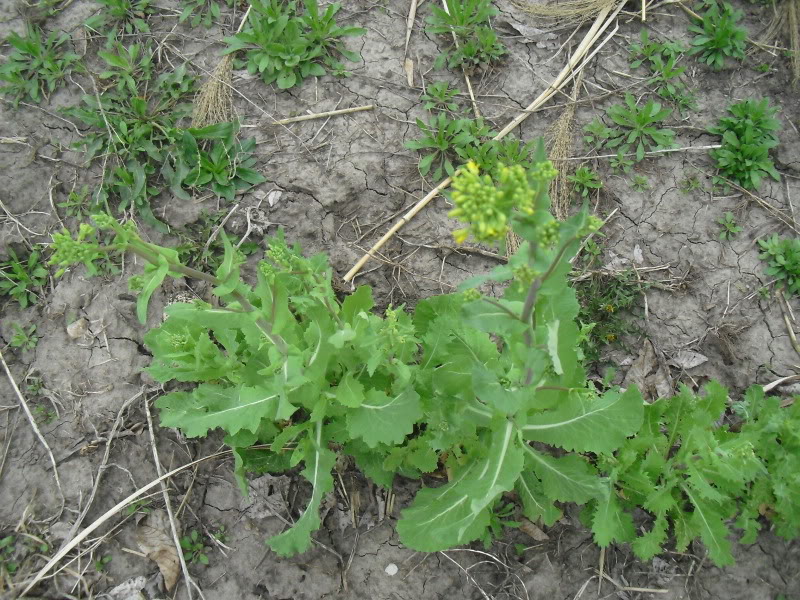
These things can become almost invasive not unlike wild mustard if allowed to go to seed!
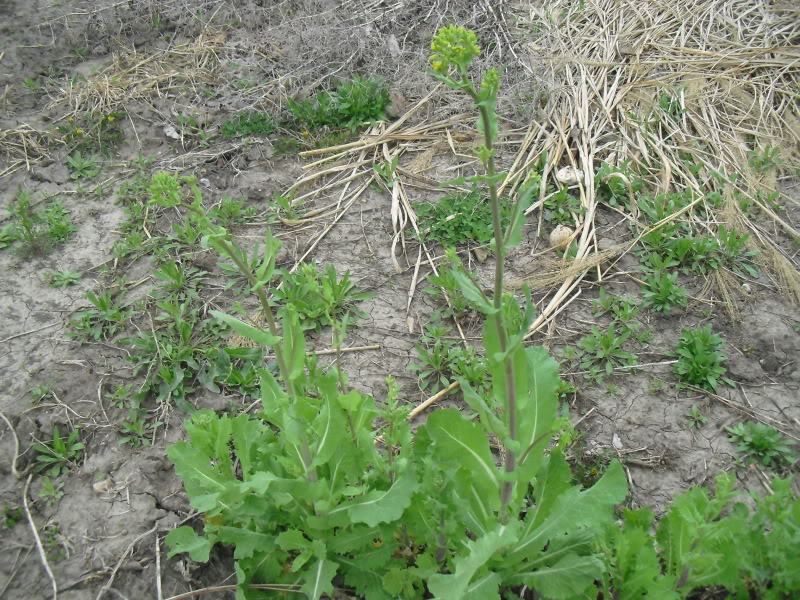
Get them sprayed or tilled under or you may regret it later.
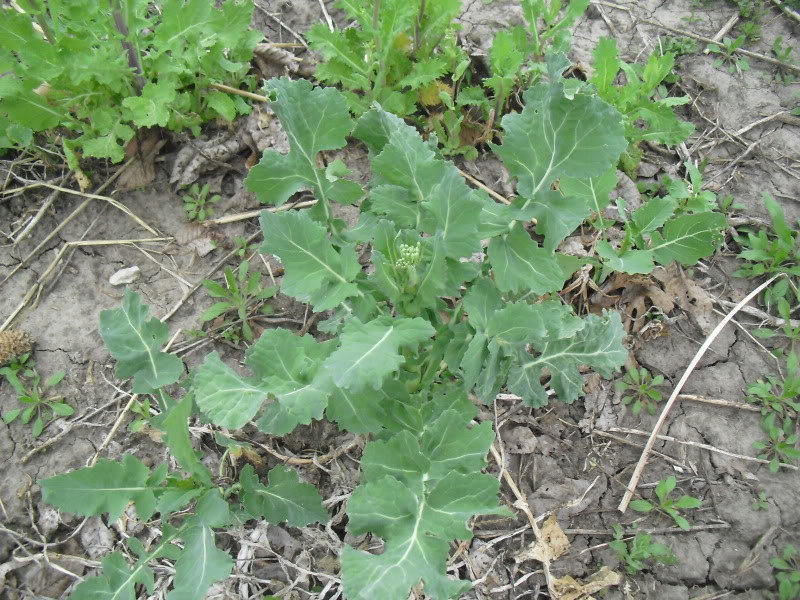
Deer will rarely touch them this time of year so there is nothing to be gained by leaving them standing and rotting dead brassicas are a haven for disease and pests. Till them under or plant RR soybeans and get them sprayed... :way:
Here is a great example why we need to turn under spent brassica plots and get them in a cover crop of oats and an annual clover like berseem or crimson. It's only April 15th and these surviving brassicas planted as a test in my garden are already going to seed!

These things can become almost invasive not unlike wild mustard if allowed to go to seed!

Get them sprayed or tilled under or you may regret it later.

Deer will rarely touch them this time of year so there is nothing to be gained by leaving them standing and rotting dead brassicas are a haven for disease and pests. Till them under or plant RR soybeans and get them sprayed... :way:
Has anyone ever planted carrots as part of their brassica mix? Not that I'd use "buck on the bag" mixes, but came across this product: Big-N-Beasty Brassicas with carrots. This mix contains; Sugar Beets, Purple Top Forage Turnip, Carrots, Winfred Forage Rape, Dwarf Essex Rape, and Hunter Forage Rape/Turnip Hybrid.